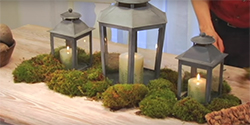Why a Tree? The History Behind Christmas Trees

For many families, a tree becomes the beautiful centerpiece of holiday celebrations at Christmastime. But how did this element of our festive winter season become so widely loved? Join us at Pottery Barn to learn more about Christmas tree history and discover how this treasured holiday tradition has changed and grown.
Ancient Roots
Although we don’t know much about the earliest origins of Christmas trees, many historians believe that people were using trees as part of their religious winter-holiday celebrations. Before Christianity became popular in Europe, many people practiced pagan religions that incorporated rituals and other elements related to nature and plants. The pagan holiday season Saturna took place around the winter solstice. This coincides with our December Christmas season.
Many smaller religions around Europe celebrated natural elements in the world around them. They saw the changing seasons as reasons to host holiday festivities. Evergreen trees were given a special status for winter celebrations. Phillip Shaw, a linguist and history researcher at Leicester University in the United Kingdom, notes that many families maintained these honored traditions, even when they later adopted Christian beliefs. Just as we pass on family holiday traditions now, early European Christians wanted to honor their ancestors’ rituals. We can’t trace the exact path Christmas trees followed into the current day, but this symbol of love, celebration and giving was important to many of our early relatives.
European Origins
Unlike the colorful, dazzling tree you might set up in your home, early Christmas trees were mostly undecorated. However, as more people adopted Christian beliefs, they began using Christian symbols in their winter holiday celebrations. According to the National Christmas Tree Association, the first official record of a decorated Christmas tree dates back to the early 16th century. Latvian villagers decorated a tree with roses – a symbol of the Virgin Mary.
By 1530, merchants in the Alsace region of France had started selling cut trees that were about 4' tall. These trees were also undecorated. People set them up in their homes, and soon the practice spread into Germany. By the 1700s, it was common for families to decorate their trees with apples, sweets and paper ornaments. Many early ornaments were made from edible things like fruit and berries, and people found most of their decorations outside. The favorite Christmas symbols we love seeing today didn’t develop until much later.
The Modern Christmas Tree as We Know It
According to some historians, Queen Elizabeth II‘s great-great grandmother started our love of tinsel-trimmed trees. Queen Victoria of Great Britain was a trendsetter in her day – she even influenced the furniture style people preferred. Victoria and her German husband, Prince Albert, celebrated an ornate Christmas with their children every year during the mid 1800s. Their festivities included a Christmas tree decorated with candles, fruit and handmade ornaments.
British people loved the way that the royal family celebrated Christmas, and they used those ideas as a basis for their own decorations. Prince Albert also sent decorated trees to military barracks and schools in the area around Windsor Castle. Other elements of Victoria and Albert’s Christmas celebrations, including red sleighs dashing through the snow, influenced the decorations people started setting up in their homes. The British trees were likely the start of the Christmas decorations that we recognize today.
Also during the 1800s, immigrants from Germany and other Northern European countries were bringing their traditions across the Atlantic to the United States. These new residents started setting up trees in their homes and selling cut trees to other people from different cultural backgrounds. Our national love affair with the Christmas tree caught on.
Most trees during this time weren’t the grand ones we think of today. Many were small enough to fit on a dining table! But by the end of the century, floor-to-ceiling trees had become more popular. Christmas tree farms in Norway and the United States started growing to meet people’s increasing desire for larger trees. Today, these farms provide enough trees to supply the 30-50 million people in the United States who bring home fresh live trees every Christmas season. If you set up a Christmas tree this year, have fun thinking about the centuries of interesting history behind a tradition that’s perfect for sharing with loved ones!


